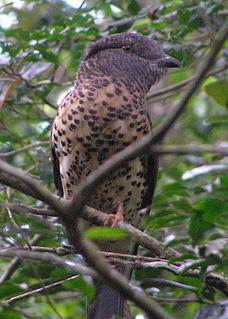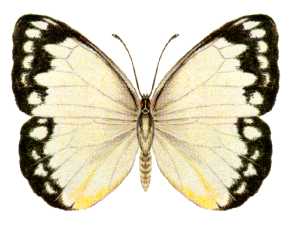
The cuckoo roller or courol is the only bird in the family Leptosomidae, which was previously often placed in the order Coraciiformes but is now placed in its own order Leptosomiformes. Its nearest relative is not clear. Morphological evidence may suggest a placement in or near to Falconiformes. In the rather comprehensive DNA study by Hackett et al, this and the hoatzin are the only two birds whose position is unclear, although the cuckoo roller seems to be at the root of a group that contains the Trogoniformes, Bucerotiformes, Piciformes, and Coraciiformes.

Capparis spinosa, the caper bush, also called Flinders rose, is a perennial plant that bears rounded, fleshy leaves and large white to pinkish-white flowers.

The prairie warbler is a small songbird of the New World warbler family.

The white-tailed titi, Plecturocebus discolor, is a species of titi, a type of New World monkey, from South America. It is found in Colombia, Ecuador and Peru. It was described in 1848 as Callicebus discolor.
Capparis crotonantha is a species of plant in the Capparaceae family. It is endemic to Panama.

Capparis is a flowering plant genus in the family Capparaceae which is included in the Brassicaceae in the unrevised APG II system. These plants are shrubs or lianas and are collectively known as caper shrubs or caperbushes. Capparis species occur over a wide range of habitat in the subtropical and tropical zones.
Cynophalla heterophylla is a species of flowering plant in the family Capparaceae. It is endemic to Ecuador. Its natural habitats are subtropical or tropical dry forests and subtropical or tropical dry shrubland. It is threatened by habitat loss.
Capparis mirifica is a species of plant in the Capparaceae family. It is endemic to Panama. It is threatened by habitat loss.
Capparis mollicella is a species of plant in the Capparaceae family. It is endemic to Mexico and Costa Rica.
Capparis pachyphylla is a species of plant in the family Capparaceae. It is endemic to India.
Capparis panamensis is a species of plant in the Capparaceae family. It is endemic to Panama. It is threatened by habitat loss.

Capparis sandwichiana is a species of flowering plant in the Capparaceae family endemic to the Hawaiian Islands. Common names include maiapilo, pua pilo, and Hawaiian caper. C. sandwichiana can be found on the main islands, Midway Atoll, the Pearl and Hermes Atoll, and Laysan. It inhabits coastal low shrublands and rocky shores at elevations from sea level to 325 feet (99 m). Maiapilo is listed as vulnerable by the IUCN and is threatened by grazing, competition with invasive species, and habitat destruction.
Capparis sprucei is a species of plant in the Capparaceae family. It is endemic to Peru.
Capparis uniflora is a species of plant in the Capparaceae family. It is endemic to Panama.
Guioa discolor is a species of plant in the family Sapindaceae. It is endemic to the Philippines.
Trema discolor is a species of plant in the Cannabaceae family. It is endemic to French Polynesia.

Spix's red-handed howler is a species of Howler monkey native to the southeastern Amazon in Brazil. It is threatened by deforestation and hunting.

Cepora perimale, the caper gull, is a butterfly in the family Pieridae. It is found on Norfolk Island and in New South Wales, the Northern Territory, Queensland, Victoria, Western Australia, Fiji, Irian Jaya, Maluku, Sulawesi, New Caledonia, Papua New Guinea, the Solomon Islands and Vanuatu.

Capparis tomentosa, the woolly caper bush or African caper, is a plant in the Capparaceae family and is native to Africa.
The Oaxacan cat-eyed snake is a species of snake in the family Colubridae. It is the only species in the genus Tantalophis.












